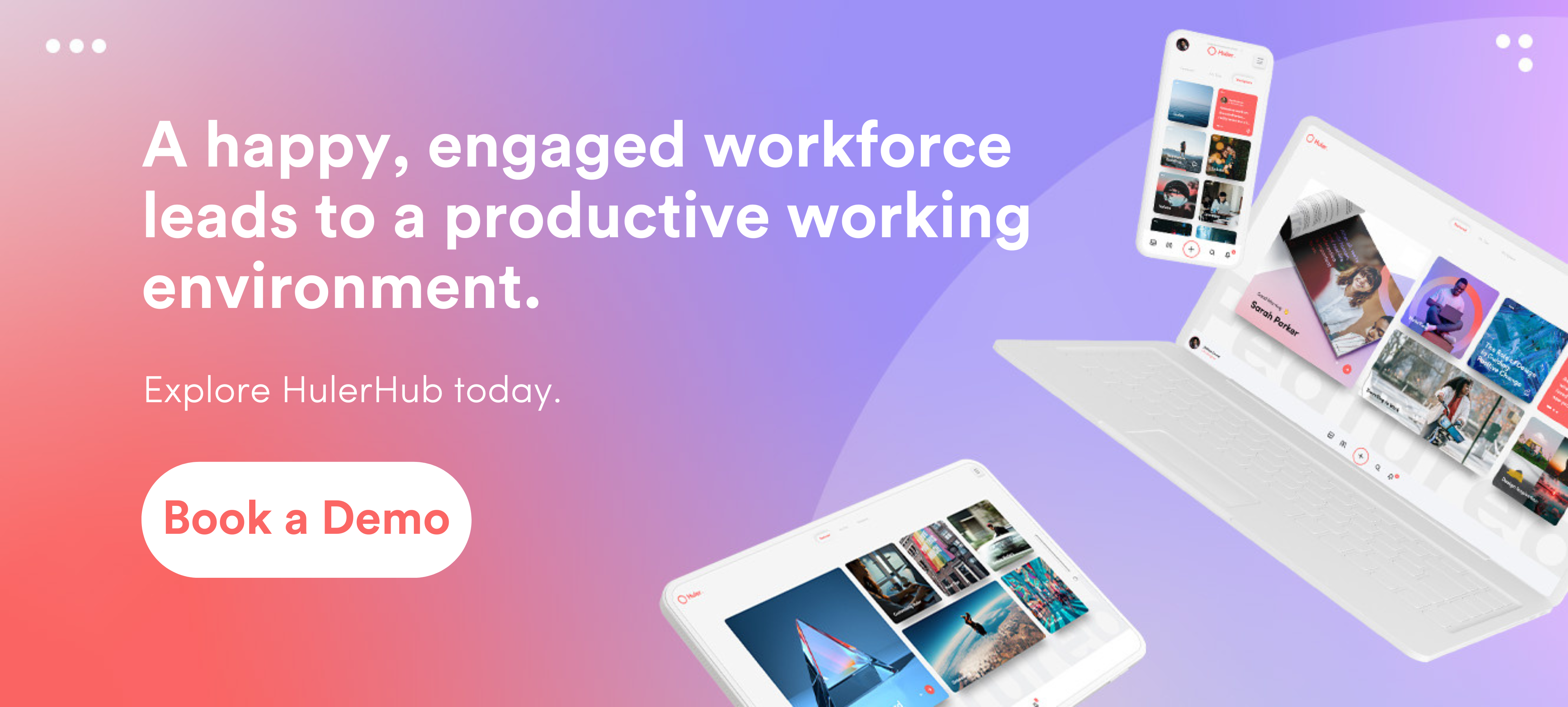Work habits and processes are changing. Hybrid and remote working is becoming the norm. There’ll be no return to the days of nine-to-five shifts in the office. In fact, research suggests that 51% of workers would consider leaving their current role if the option for hybrid work was removed.¹ This means the way businesses share information, and improve internal communication, is more important than ever.
Combine this with the fact that internal communication has far-reaching outcomes that can influence an entire organisation, and it becomes clear that businesses need to work to improve their internal communication strategy using the latest tools and systems.
This means simplifying your internal communication systems, while getting creative with how you communicate information to employees.
In this article, we’re going to delve into the importance of using an internal communication software for business and examine the steps you can take to optimise your approach.
Why is internal communication so important?
Communication is an essential part of everyday life. It’s how we share and build on each other’s ideas and thoughts. This is true in business, too, as channels for clear communication can make or break a team’s ability to succeed.
Effective communication can significantly contribute to a company’s morale, productivity and efficiency. Frequent internal communication can also optimise the way work is done and help ensure everyone is on the same page. Statistics show that staff productivity increases by 25% in organisations where employees feel connected.²
Step 1. Ensure your company’s values and goals are clear
Not knowing company goals is a major contributor to broken connections and poor internal communication. And this issue is more common than you think. In fact, 72% of employees don’t completely understand their company’s strategy.³
If an employee isn’t aware of a company’s goals and values, it’s only natural for them to disconnect. The business needs a big picture view of what they’re doing and why so that their employees can find purpose and value in their work. This is why conveying business goals to your workforce is so important. It’s a meaningful way to unify staff and create an end goal or target to focus on.
By being clear on business-wide objectives, everyone will be on the same page and can then better relate to the reason behind their tasks and day-to-day workload. By sharing these values clearly, businesses will see enhanced collaboration and enable teams to tackle issues presented to them more readily.
How do you put this into action? Well, 85% of employees say they’re most motivated when management offers regular updates on company news.⁴ Consider ways to keep your staff updated on your business’ game plan. Periodic emails, calls, or even quick briefs on such information can be a great way to engage employees and keep everyone in the loop.
You can go one step further with the help of the latest cutting-edge tools. For example, with a system like the HulerHub, businesses can keep relevant, engaging content, like quarterly updates on business objectives, in one centralised dashboard that notifies employees when new updates arrive.
Step 2. Create an open dialogue
Everyone wants to be heard, and everyone has an opinion. The challenge is that not all voices are always given an equal platform, which quickly leads to disengagement, negatively impacting morale.
It’s pretty simple, enable open communication within the workplace, and you’ll start hearing new, exciting ideas. This will only help improve the current state of your business.
Allowing for open dialogue can be done in a variety of ways. Here are a few ideas:
- Put policies in place that encourage people to speak up and offer their ideas instead of making people do so with formal meetings or forced interactions. This freedom creates independence and empowers those who wish to speak, and can have a positive, knock-on effect on quieter employees and team members who may have thoughts they want to share.
- Hold regular meetings or forums where employees can share their thoughts. These are most effective when the employees involved already interact with each other regularly, as this helps ensure everyone is comfortable sharing ideas. This feedback can then be collected from each team and shared on a broader scale through newsletters or larger virtual platforms, such as business-wide meetings.
- An open-door policy is a highly effective way to encourage any and all employees to share concerns, thoughts or just anything they want off their chest privately and more confidentially.
- Including pulse surveys or listening surveys that can be reviewed often can help businesses stay on top of what matters most to employees and how they can improve.
Employees want to feel heard and listened to. Enabling this goes a long way to help improve employee satisfaction and drive better business communication.
Step 3. Include everyone
To have successful and consistent communication in the workplace, it’s vital that everyone feels included. This can be done in various ways, such as department meetings, town hall meetings and even using social tools — from social media to social activities.
Making sure that everyone, remote and in-house, has a voice (and a face) allows for better two-way communication and helps with transparency — an essential ingredient in any healthy workplace.
Step 4. Plan external events and get-togethers
Spending time away from the office with colleagues and not focusing on work can go a long way to improving engagement and communication within your business.
With hybrid and remote working, it’s likely that some of your employees may have never physically met other team members in person. And it’s always nice to put a (real) face to a name that you email daily.
Allowing staff to become more than just colleagues, gatherings like this build the development of personal connections between employees and supports their ability to collaborate in doing so. This makes work interactions much more friendly and conversational, allowing for a more fluid form of communication.
Step 5. Recognise talent
When goals are set, you expect them to be met. When they are met, do you recognise those who made it possible? If your answer is no, you may need to reevaluate your approach.
Recognising an employee or team’s talent, achievements, and individuals within your company is a great way to improve your team’s morale and drive friendly competition and motivation. It also helps other departments stay in the loop in what is happening across the business and the successes you are having.
This doesn’t need to be a massive award ceremony either. Although planned occasions such as award presentations work, a simple chat with a team or individual who has done well can go a long way. Peer recognition, not just from management, has a huge positive impact on employee engagement and experience.
Building a culture based on celebrating each other’s wins, creates a much happier environment for everyone. Having a scheduled monthly awards or talent recognition newsletter or meeting is also great for those involved — displaying that your business is one great team full of talented people.
Step 6. Allow ‘downtime’
Working long hours is exhausting for everyone — physically and mentally. When people are constantly on edge and feeling the pressure to always work, it takes a toll. This can be destructive to someone’s quality of life and the quality of communication within a business.
This is why it’s essential to allow some downtime for employees. This could be in the form of flexible hours adding to the work-from-anywhere mentality to work at any time (within reason).
Offering looser start and stop times when working from home or encouraging breaks can reduce the stress of work. Giving people this time to relax and enabling them to approach their work with fresh eyes can help them be more effective when communicating with their team.
HulerHub allows employees to personalise their virtual workspaces with necessary tiles – for example, a tile dedicated to their favourite news site or sports team. This will enable them to customise their digital working environment, making it less intimidating, and allowing them to have a small break between tasks to consume information on the things they care about. A little bit of freedom and flexibility goes a long way.
Step 7. Make internal knowledge easily available
Not all information and communication is person-to-person. Some sharing of information will be in the form of documents, videos, and links. This type of communication is just as important as where company-specific information and processes are stored. Still, it can be challenging to benefit from if it’s not easy to find or hidden within multiple folders or complicated intranet journeys.
Unfortunately, this is the state of affairs for many businesses, as it’s been discovered that only 13% of employees use their intranet daily.⁵ Even more astounding, 31% of employees surveyed by Prescient Digital Media admitted that they have never even used their intranets.⁶
Most people would prefer information to be laid out in an easily consumable way. Suppose it takes too much effort to track down the correct information. In that case, people will become frustrated, affecting their productivity.
It’s crucial to have a system that makes critical internal resources easily available to those who need them. HulerHub is an internal communications platform built to solve this problem. Through collections and sharing functions, suitable materials can be sent to the right people efficiently – skipping any awkward or long-winded pathways, taking your employees right to where they need to be.
Suggested reading: For more details on improving your business’s internal communication, check out our new eBook — Solving the Employee Experience Crisis.
Ensure you have the right tools to communicate effectively
A business’s ability to collaborate is only as good as the tools and systems they use. Tools such as Slack, Microsoft Teams and Skype are amongst the most commonly used, but there are a host of other options available.
But when it comes to choosing the right internal comms system for your business, you need to ensure it has the capacity to meet the demands of a distributed workforce. That’s where Huler comes in.
HulerHub improves and streamlines all your internal communications through unique tiles and sharing functionalities, making all the right people and information easy to access. It also comes with a smart notification centre that can collate group messages, changes and updates, so no one misses a beat.
To have a successful communication system in your business, it’s crucial that you include everyone, recognise talent and allow for some downtime. You should also ensure you have the right tools to communicate effectively. With the rise of remote work and hybrid teams, using HulerHub can help improve and streamline your internal communications. Book a free demo and try it today.
² Research Says Companies That Do This 1 Thing Increase Worker Productivity by 25 Percent | Inc.com
³ 24 Internal Communications Statistics Your Company Should Know
⁴ Using Internal Communications Tactics To Keep Remote Workers Connected
⁶ Employee Intranet Statistics 2022 – Everything You Need to Know








